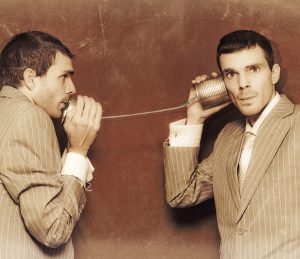Innovation Needs Communication
 In 2014, Thomas Royen, a retired German statistician, solved a puzzle that had stumped mathematicians for decades. Called the Gaussian correlation inequality, it involves the probability of a random point lying in overlapping shapes and is one of those seemingly simple mathematical ideas that is devilishly hard to figure out.
In 2014, Thomas Royen, a retired German statistician, solved a puzzle that had stumped mathematicians for decades. Called the Gaussian correlation inequality, it involves the probability of a random point lying in overlapping shapes and is one of those seemingly simple mathematical ideas that is devilishly hard to figure out.
Yet the mathematics community was skeptical. Royen published his proof, which was not formatted in the standard way, in an obscure journal where he sat on the editorial board. So many simply assumed that Royen’s work was just another of the many false proofs that had emerged over the years.
Eventually, two other mathematicians restructured Royen’s paper, published it on arXiv.org and his work was recognized, but it could have easily been lost for another generation. “I am not so talented for ‘networking’ and many contacts.†Royen said dismissively, but his apathy points to a larger problem. Innovating is not just about ideas, but communicating them.
The Curious Case Of Ignaz Semmelweis
In the 1850’s, Ignaz Semmelweis was a doctor at the obstetric ward of Vienna General Hospital.  Appalled by the number of deaths in the ward, he instituted a strict regime of hand washing and virtually eliminated the childbed fever that was endemic at the time. Alas, things did not go well from there.
Instead of being lauded for his accomplishment, he was castigated and considered a quack. Part of the problem was that Semmelweis’s ideas about hand washing conflicted with the prevailing miasma theory of the day. It was widely thought at the time that “bad airsâ€, not bacteria, caused disease. So hand washing simply didn’t make any sense to the medical profession at the time.
Yet as Sherwin Nuland explains in The Doctor’s Plague, there’s more to the story than that. Semmelweis, much like Thomas Royen, didn’t see the value in communicating his work effectively, formatting his publications clearly or even collecting data in a manner that would gain his ideas greater acceptance. Untold millions died because of it.
Luckily, those that came later, like Louis Pasteur, Joseph Lister and Robert Koch were more attentive and helped establish the germ theory of disease. The truth is that ideas alone, even breakthrough ideas, rarely amount to much. Innovations need to be communicated effectively if they are to spread and make an impact on society.
The Balkanization of Knowledge
Unlike Semmelweis, the natives of Tasmania, a small island off the coast of Australia did not choose their isolation. About 10,000 years ago the land bridge that connected it to the mainland was submerged under the sea, cutting off all access to the larger population. The people of Tasmania were left on their own.
As Jared Diamond described in Guns, Germs, and Steel, this not only cut off Tasmania from advancements that Australians came up with after the split. The societies there actually regressed, losing much of the technology that they previously knew how to make. Again, innovation is not just about ideas, it is also about people and their interactions.
Sometimes the barriers are not only geographical, but linguistic and cultural. Gregor Mendel’s discovery of genetics was nearly lost to history, because as a Bavarian monk, he was out of the scientific mainstream of his time. In a similar vein, without G.H. Hardy to help translate his work into formal mathematical proofs, the genius of Ramanujan would likely been lost.
Even with digital technology, which has largely broken down barriers of time and space, conceptual barriers still remain. On the InnoCentive platform, which offers bounties for solving problems that seem to defy conventional methods, answers to seemingly intractable problems always seem to come from specialists in some adjacent domain, not that in which they arose.
Technology can help here. Consider the Materials Genome Initiative, which aggregates a dizzying array of interdisciplinary knowledge that encompasses chemistry, physics and engineering for use in industries as diverse as manufacturing and renewable energy. Yet because the data is made machine readable, it is highly accessible for anyone who wants to use it, whatever their background.
The Increasing Importance Of Teams
In an article in Harvard Business Review, Bain & Co. partner Michael Mankins estimates that while a typical executive in the 1970’s might have received 1,000 messages a year, that number has skyrocketed to more than 30,000 today. He points out that the increased level of communication means that we have little time for uninterrupted work.
Mankins sees this as a bad thing, but the truth is that the nature of work has changed. Part of the reason that earlier executives communicated less was that they were so busy doing grunt work. Today, however, those rote tasks have largely been automated. As Mankins himself wrote in an earlier article, “Today, an algorithm can assemble many more facts about the accounts than any human being could easily process.â€
That’s enabled us to tackle far more difficult problems, which requires us to work closely with others who can add their skills to ours. Today, even in highly technical fields, there is a strong trend toward teams rather than solitary work, and those teams are getting larger, the work they do is more interdisciplinary and is done at greater distances than in the past.
The truth is that chief task of humans today is increasingly to work with other humans to design jobs for machines. Clearly, that means we need to spend a lot more time and effort communicating with others than sitting alone at our desks. Increasingly, we live in a social economy with collaboration at its center. It is no longer just efficiency, but agility and interoperability that makes firms successful.
140 Characters Are Actually Better Than A Flying Car
Silicon Valley investor Peter Thiel is fond of pointing out that in earlier visions of the future, we were promised flying cars, but got 140 characters instead. It’s one of those glib but witty statements that tend to get a lot of attention. Sure, our lives bear little resemblance to a Buck Rogers comic book, but so what?
When you think about it, 140 characters are actually better than a flying car. Even if we had flying cars, where would we go with them? Who would we see? How would it make our lives measurably better?
Now imagine that earlier generations had the Internet. If Gregor Mendel had been able to post his work on the web, the field of genetics might very well be decades ahead of where it is now. If Ramanujan had been able to tweet to Hardy and other mathematicians, how much more effective could their collaboration have been?
The problems we solve today are exponentially more difficult and complex than in the past and we need to collaborate across boundaries of not only time and space, but language, culture and skill set. That will take more than just ideas. The challenges ahead will require us to combine ideas and the people who have them.
An earlier version of this article first appeared in Inc.com
Wait! Before you go…
Choose how you want the latest innovation content delivered to you:
- Daily — RSS Feed — Email — Twitter — Facebook — Linkedin Today
- Weekly — Email Newsletter — Free Magazine — Linkedin Group
 Greg Satell is a popular speaker and consultant. His first book, Mapping Innovation: A Playbook for Navigating a Disruptive Age, was selected as one of the best business books in 2017. Follow his blog at Digital Tonto or on Twitter @Digital Tonto.
Greg Satell is a popular speaker and consultant. His first book, Mapping Innovation: A Playbook for Navigating a Disruptive Age, was selected as one of the best business books in 2017. Follow his blog at Digital Tonto or on Twitter @Digital Tonto.
NEVER MISS ANOTHER NEWSLETTER!
LATEST BLOGS
How Brexit Has Affected UK E-commerce Businesses
Photo by Zyro on Unsplash The popularity of online shopping was already growing at an impressive rate – and…
Read MoreOvercoming range anxiety: three tips for EV owners
Photo by Jenny Ueberberg on Unsplash In the last few years, electric vehicles (EVs) have become more and more…
Read More


